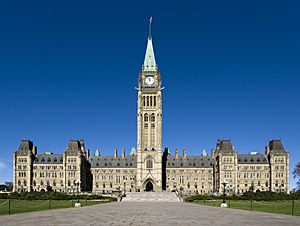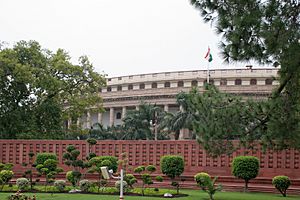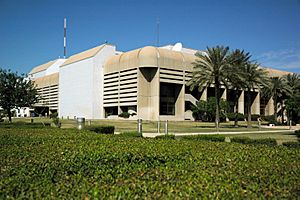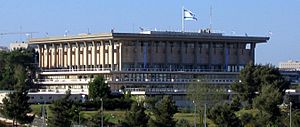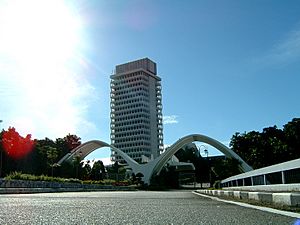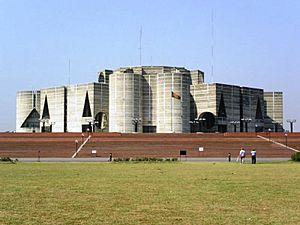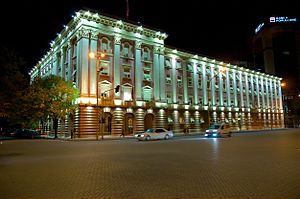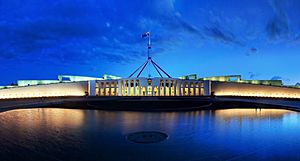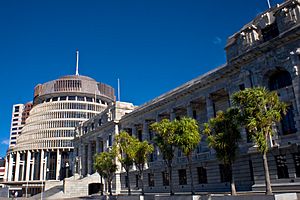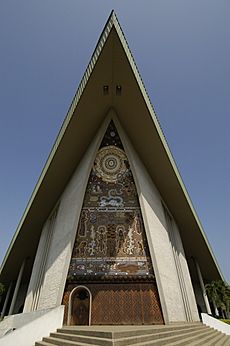Parliamentary system facts for kids
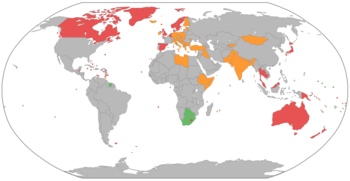
A parliamentary system of government means that the executive branch of government has the direct or indirect support of the parliament. This support is usually shown by a vote of confidence. The relationship between the executive and the legislature in a parliamentary system is called responsible government.
The separation of powers between the executive and law making branches, is not as obvious as it is in a presidential system, so there are different ways of balancing powers between the three branches which govern the country (the executive (or ministers), the law makers and the judges).
Parliamentary systems usually have a head of government and a head of state. The head of government is the prime minister, who has the real power. The head of state often is an elected (either popularly or through parliament) president or, in the case of a constitutional monarchy, hereditary.
Countries
Africa
| Country | Connection between the legislature and the executive |
|---|---|
| Parliament of Botswana elects the President who appoints the Cabinet | |
| Federal Parliamentary Assembly appoints the Council of Ministers | |
| National Assembly appoints the Cabinet of Mauritius | |
| Federal Parliament of Somalia elects the President who appoints the Prime Minister | |
| Parliament of South Africa elects the President who appoints the Cabinet |
Americas
| Country | Connection between the legislature and the executive |
|---|---|
| Leader of the political party that has the support of a majority in the House of Representatives of Antigua and Barbuda is appointed Prime Minister of Antigua and Barbuda by the Governor-General of Antigua and Barbuda, who then appoints the Cabinet of Antigua and Barbuda on the advice of the Prime Minister | |
| Leader of the political party that has the support of a majority in the House of Assembly of the Bahamas is appointed Prime Minister of the Bahamas by the Governor-General of the Bahamas, who then appoints the Cabinet of the Bahamas on the advice of the Prime Minister | |
| Leader of the political party that has the support of a majority in the House of Assembly of Barbados is appointed Prime Minister of Barbados by the Governor-General of Barbados, who then appoints the Cabinet of Barbados on the advice of the Prime Minister | |
| Leader of the political party that has the support of a majority in the House of Representatives of Belize is appointed Prime Minister of Belize by the Governor-General of Belize, who then appoints the Cabinet of Belize on the advice of the Prime Minister | |
| Leader of the political party that has the support of a majority in the House of Commons of Canada is appointed Prime Minister of Canada by the Governor General of Canada, who then appoints the Cabinet of Canada on the advice of the Prime Minister | |
| Parliament approves the Cabinet of Dominica | |
| Leader of the political party that has the support of a majority in the House of Representatives of Grenada is appointed Prime Minister of Grenada by the Governor-General of Grenada, who then appoints the Cabinet of Grenada on the advice of the Prime Minister | |
| Leader of the political party that has the support of a majority in the House of Representatives of Jamaica is appointed Prime Minister of Jamaica by the Governor-General of Jamaica, who then appoints the Cabinet of Jamaica on the advice of the Prime Minister | |
| Leader of the political party that has the support of a majority in the National Assembly of Saint Kitts and Nevis is appointed Prime Minister of Saint Kitts and Nevis by the Governor-General of Saint Kitts and Nevis, who then appoints the Cabinet of Saint Kitts and Nevis on the advice of the Prime Minister | |
| Leader of the political party that has the support of a majority in the House of Assembly of Saint Lucia is appointed Prime Minister of Saint Lucia by the Governor-General of Saint Lucia, who then appoints the Cabinet of Saint Lucia on the advice of the Prime Minister | |
| Leader of the political party that has the support of a majority in the House of Assembly of Saint Vincent and the Grenadines is appointed Prime Minister of Saint Vincent and the Grenadines by the Governor-General of Saint Vincent and the Grenadines, who then appoints the Cabinet of Saint Vincent and the Grenadines on the advice of the Prime Minister | |
| National Assembly elects the President, who appoints the Cabinet of Suriname | |
| Parliament of Trinidad and Tobago approves the Prime Minister of Trinidad and Tobago |
Asia
| Country | Connection between the legislature and the executive |
|---|---|
| Jatiyo Sangshad approves the Cabinet of Bangladesh | |
| Parliament of Bhutan approves the Lhengye Zhungtshog | |
| Parliament of Cambodia approves the Council of Ministers | |
| President of India appoints the leader of the political party or alliance that has the support of a majority in the Lok Sabha as Prime Minister of India, who then forms the Union Council of Ministers | |
| Council of Representatives approves the Cabinet of Iraq | |
| Leader of the political party with the most Knesset seats in the governing coalition is appointed Prime Minister of Israel by the President of Israel. The Prime Minister then appoints the Cabinet of Israel. | |
| National Diet nominates the Prime Minister who appoints the Cabinet of Japan | |
| National Assembly approves the Crown Prince who appoints the Prime Minister who appoints the Cabinet of Kuwait | |
| Supreme Council approves the Cabinet of Kyrgyzstan | |
| Maronite Christian president is elected by the Parliament of Lebanon. He appoints the Prime Minister (a Sunni Muslim) and the cabinet. The Parliament thereafter approves the Cabinet of Lebanon through a vote of confidence (a simple majority). | |
| Parliament of Malaysia appoints the Cabinet of Malaysia | |
| Assembly of the Union, by an electoral college, elects the President who forms the Cabinet of Myanmar | |
| Parliament of Nepal elects the Prime Minister who, by turn, appoints the Cabinet of Nepal | |
| Parliament of Pakistan appoints the Cabinet of Pakistan | |
| Parliament of Singapore approves the Cabinet of Singapore | |
| The Monarch appoints the MP nominated by in the House of Representatives (usually the leader of the largest party or coalition) as Prime Minister, who forms the Cabinet of Thailand. Under the current junta, the appointee is nominated by the National Legislative Assembly. |
Europe
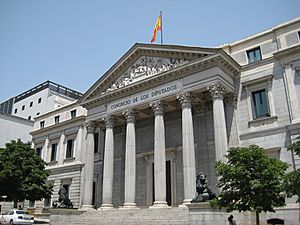
| Country | Connection between the legislature and the executive |
|---|---|
| Parliament of Albania approves the Cabinet of Albania | |
| National Assembly appoints and (no sooner than one year) can dismiss through the constructive vote of no confidence the Government of Armenia | |
| In theory, chancellor and ministers are appointed by the President. As a practical matter, they are unable to govern without the support (or at least toleration) of a majority in the National Council. The cabinet is politically answerable to the National Council and can be dismissed by the National Council through a motion of no confidence. | |
| Federal Parliament approves the Cabinet of Belgium | |
| National Assembly appoints the Council of Ministers of Bulgaria | |
| Croatian Parliament approves President of Government and the Cabinet nominated by him/her. | |
| President of the Czech Republic appoints the leader of the largest party or coalition in the Chamber of Deputies of the Parliament as Prime Minister, who forms the Cabinet. The Prime Minister must gain a vote of confidence by the Chamber of Deputies. | |
| The Monarch appoints, based on recommendations from the leaders of the parties in Folketinget, the cabinet leader who is most likely to successfully assemble a Cabinet which will not be disapproved by a majority in Folketinget. | |
| Riigikogu elects the Prime Minister candidate nominated by the President of the Republic (normally this candidate is the leader of the parliamentary coalition of parties). The Government of the Republic of Estonia is later appointed by the President of the Republic under proposal of the approved Prime Minister candidate. The Riigikogu may remove the Prime Minister and any other member of the government through a motion of no confidence. | |
| Parliament of Finland appoints the Cabinet of Finland | |
| Bundestag elects the Federal Chancellor (after nomination from the President of Germany), who forms the Cabinet | |
| Hellenic Parliament approves the Cabinet of Greece | |
| National Assembly approves the Cabinet of Hungary | |
| The President of Iceland appoints and discharges the Cabinet of Iceland. Ministers can not even resign without being discharged by presidential decree. | |
| Dáil Éireann nominates the Taoiseach, who is then appointed by the President of Ireland | |
| Italian Parliament grants and revokes its confidence in the Cabinet of Italy, appointed by the President of Italy | |
| Assembly of Kosovo appoints the Government of Kosovo | |
| Saeima appoints the Cabinet of Ministers of the Republic of Latvia | |
| Chamber of Deputies appoints the Cabinet of Luxembourg | |
| House of Representatives appoints the Cabinet of Malta | |
| Parliament of Moldova appoints the Cabinet of Moldova | |
| Parliament of Montenegro appoints the Government of Montenegro | |
| Second Chamber of the States-General can dismiss the Cabinet of the Netherlands through a motion of no confidence | |
| Assembly approves the Government of North Macedonia | |
| The Monarch appoints the MP leading the largest party or coalition in Stortinget as Prime Minister, who forms the Cabinet | |
| National Assembly appoints the Government of Serbia | |
| National Council approves the Government of Slovakia | |
| National Assembly appoints the Government of Slovenia | |
| The Congress of Deputies elects the President of the Government, who forms the Cabinet | |
| The Riksdag elects the Prime Minister, who in turn appoints the other members of the Government | |
| A United Federal Assembly elects the members of the Swiss Federal Council | |
| The monarch appoints the MP leading the largest party or coalition in the House of Commons as Prime Minister, who forms the Cabinet |
Oceania
| Country | Connection between the legislature and the executive |
|---|---|
| Leader of the political party that has the support of a majority in the Australian House of Representatives is appointed Prime Minister of Australia by the Governor-General of Australia, who then appoints the Cabinet of Australia on the advice of the Prime Minister | |
| Leader of the political party that has the support of a majority in the New Zealand House of Representatives is appointed Prime Minister of New Zealand by the Governor-General of New Zealand, who then appoints the Cabinet of New Zealand on the advice of the Prime Minister | |
| Leader of the political party that has the support of a majority in the National Parliament is appointed Prime Minister of Papua New Guinea by the Governor-General of Papua New Guinea, who then appoints the Cabinet of Papua New Guinea on the advice of the Prime Minister | |
| Legislative Assembly appoints the Cabinet of Samoa | |
| Parliament of Vanuatu appoints the Cabinet of Vanuatu |
Images for kids
-
The Palace of Westminster in London, United Kingdom. The Westminster system originates from the British Houses of Parliament.
-
The Reichstag Building in Berlin, Germany. The Consensus system is used in most Western European countries.
-
Jatiya Sangsad Bhaban, parliament building of Bangladesh
See also
 In Spanish: Parlamentarismo para niños
In Spanish: Parlamentarismo para niños


